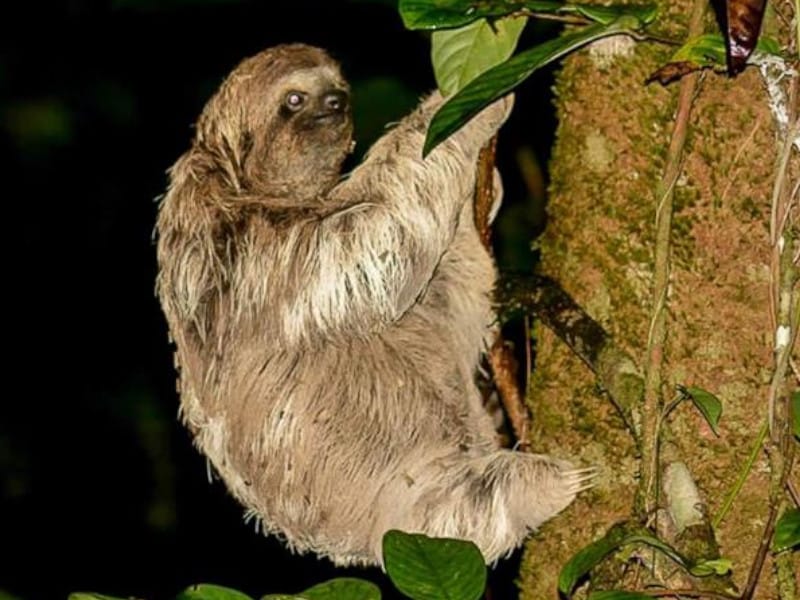Would you like to meet the Sloths in their natural habitat? No cages or artificial habitats? This sloth watching guide will help you find the right place and time.

The tropical rainforest of Bijagua is an ideal natural habitat for Sloth watching due to its warm and humid climate, which provides an abundance of food and shelter for sloths.
Sloths are herbivores and feed on a variety of leaves, including those from cecropia trees and other plants found in the rainforest.
Despite their slow movements, sloths play an essential role in the ecosystem of the tropical rainforest.
They help to disperse seeds, and their fur provides a habitat for algae, which supports a range of other organisms.
Sloths are fascinating creatures that have adapted to life in the tropical rainforest of Bijagua.
Their unique habitat and slow movements make them a vital part of the ecosystem, and they play an essential role in maintaining the balance of this fragile ecosystem.
Importance of sloth watching for ecotourism and forest conservation
Sloth watching has become an increasingly popular activity for ecotourists in recent years.
This is due to the unique and fascinating nature of these animals, as well as the important role they play in forest conservation.

Sloth watching not only provides a unique experience for tourists, but it also supports forest conservation efforts.
Sloths are important indicators of forest health, with their presence and behavior serving as an indication of the overall ecosystem.
Now a days, sloth watching is an important activity for ecotourism and forest conservation.
It provides a unique and educational experience for tourists, supports conservation efforts, and generates economic benefits for local communities.
By promoting responsible wildlife watching, we can ensure the long-term protection of these fascinating animals and their habitats.
How to spot a sloth in its natural habitat?
Sloths are arboreal creatures that spend most of their lives in trees, making them difficult to spot in the wild.
However, with the help of trained guides, tourists can observe sloths up close and learn about their behavior and habitat.
Here we share some tips so that you can identify them and enjoy the experience of observing them.
Best times of day for sloth watching
Sloths, the slow-moving creatures that are native to Central and South America, are fascinating animals to observe in the wild.

But, when is it better to observe them? Taking a full tour of the forest without seeing a single sloth is something we don’t want to experience.
It is important to take into account that they are most active during dusk and dawn, which are the best times of day to spot them in their natural habitat.
Sloths are nocturnal animals, and they tend to sleep for up to 15 hours a day. During the remaining hours, they move slowly to eat, defecate, and mate.
If you are planning a visit to a sloth habitat, it is recommended to book a tour with a professional guide who can lead you to the best spots for observing these animals.
The best areas of the forest to find sloths
Firstly, sloths are arboreal animals, which means they spend most of their time in trees.
Therefore, it’s best to look for them in areas with tall trees and dense foliage.

Sloths can be found in both tropical and subtropical forests, but they prefer areas with a lot of vegetation, such as rainforests and cloud forests.
Another factor to consider is the type of trees that sloths prefer.
During a sloth watching tour is useful to remember that they tend to favor trees with leaves that are high in water content, such as Cecropia trees. So looking for these trees it is possible to spot some sloth.

Sloths also tend to stick to a specific tree or group of trees, so once you find one, you’re likely to find more in the same area.
It’s also worth noting that sloths are primarily active at night, so your best chance of spotting them is during the evening or early morning hours.
They are known to move slowly and spend a lot of time sleeping, so be patient and keep an eye out for any movement in the trees.
The good thing about sloths is that they won’t run from you quickly.
Visual and auditory signals to identify sloths (Audio)
Identifying sloths can be a difficult task, as these elusive creatures are often well camouflaged and blend in with their surroundings.
Fortunately, there are also several visual and auditory signals that can help us identify these fascinating animals in our sloth watching trail.
One of the most distinctive visual features of a sloth is its long, curved claws. These claws, which are up to four inches long, are specially adapted for gripping tree branches and are a key characteristic of sloths.
Additionally, sloths have a distinct facial structure, with a flat, wide nose and small eyes that are often hidden behind a mask of fur.
In terms of auditory signals, sloths are known for their distinctive vocalizations.
These include a range of sounds, from low-pitched grunts and growls to high-pitched shrieks and squeaks.
These vocalizations are often used to communicate with other sloths and to warn of potential predators.
Observing Sloths Responsibly
The impact of tourism on sloth habitat
Tourism has had a significant impact on sloth habitat, especially in regions where these creatures are endemic.
As tourism increases, so does the demand for accommodation, infrastructure development, and recreational activities, leading to the destruction of sloth habitats.

Sloths, being arboreal creatures, depend on trees for shelter, food, and mobility. However, deforestation and habitat fragmentation have reduced natural habitats, forcing sloths to adapt to new environments, which may be unsuitable for their survival.
Moreover, tourism activities such as loud music, fireworks, and vehicle traffic, can cause stress and disturbance to sloths, which may affect their behavior and health.
To mitigate the impact of tourism on sloth habitat, conservation efforts should be prioritized, such as reforestation programs and the creation of protected areas.
Sloth Tour in Costa Rica Rainforest
Include:
🕰️ Approximately 1-hour tour
👩💼 Bilingual Tour guide
🍪 Snack
📶 Wifi
🦋 Butterfly Garden
This sloth tour in Costa Rica allows you to enjoy a one-hour walk in the tropical rain forest and observe these fantastic animals in their natural environment
Note: From 5 years old and under, the tour is free of charge.



